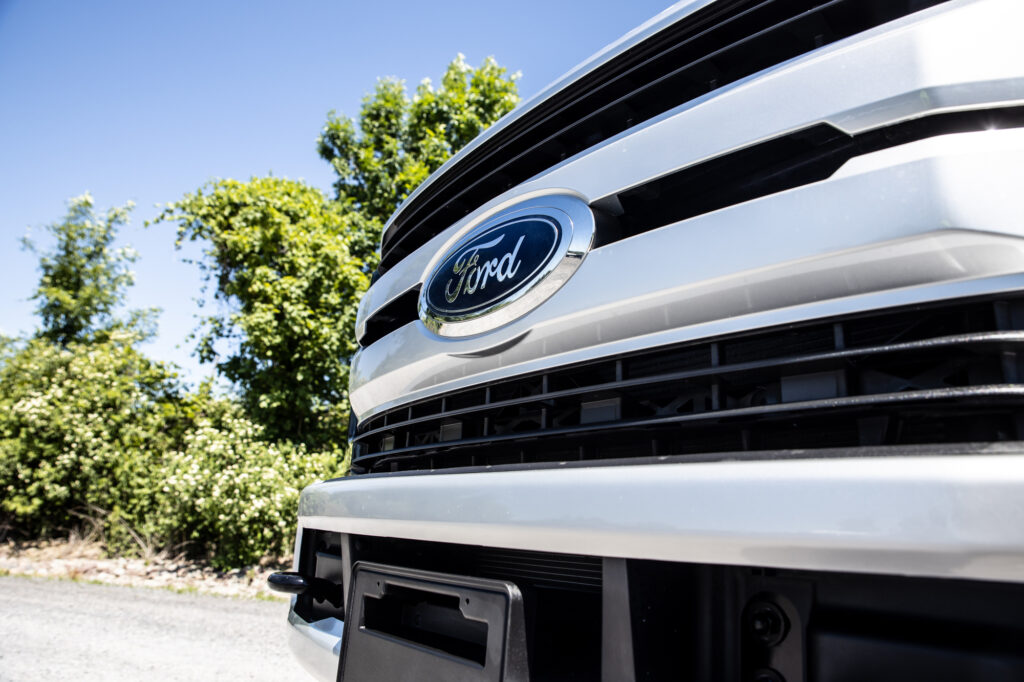The Ford F-250 and the Ford F-350 are two top-selling pickup truck models known for their industry-leading qualities and durable design.
In terms of drive quality, the Ford F250 and F350 are very similar due to their shared platform and suspension system. However, there are a few key areas where the F250 may have an advantage over the F350.

Let’s get started!
Contents
Ford F250 Overview
The Ford F250 is a full-size pickup truck in production since 1999. It is part of Ford’s F-Series lineup, which includes some of the most popular and best-selling trucks in the United States.
The current generation of the F250 was introduced for the 2021 model year and features a high-strength aluminum alloy body and a fully boxed steel frame.
This pickup model is a versatile workhorse, capable of handling tough jobs and providing a comfortable and modern driving experience. It boasts an impressive hauling capacity, clocking in at 18,500 pounds of tow power and a 4,270 maximum payload.
The Ford F250 is a powerful, capable, heavy-duty pickup truck ideal for those needing a daily driving vehicle that can handle towing and hauling large loads.
Ford F350 Overview
The Ford F350 is a heavy-duty pickup truck that easily handles some of the most demanding jobs, including commercial use and heavy towing. This model joined the F-Series lineup alongside the F250 in 1999.
When fully equipped, the F30 packs a mean punch in the ring against other heavy-load haulers, with a maximum towing capacity of up to 32,000 pounds and a maximum payload capacity of up to 7,850 pounds.
Overall, the Ford F350 offers impressive capabilities for both work and play while providing a comfortable ride quality for everyday use. Its larger size makes it ideal for those needing maximum towing or hauling ability.

Similarities
While there are certainly differences between these two models in terms of their capabilities and specifications, they share many standard features that make them both excellent choices for those who need a heavy-duty pickup truck.
Here are some key areas where these two models overlap:
Body Styles
Both Ford Super Duty trucks have similar body styles, though the optional duallys on the F350 create a wider profile.
Each pickup is available with a 6.75-foot or an 8-foot truck bed, and you can choose from Regular Cab, Super Cab, or Crew Cab.
Engine Options
The trucks mirror one another in terms of standard and available engines:
- Gasoline Engines: The F250 and F350 come with gasoline engines as standard options. The base engine for both trucks is a 6.2-liter V8 engine that delivers 385 horsepower and 430 lb-ft of torque.
- Diesel Engines: The optional diesel engine for both trucks is a 6.7-liter Power Stroke V8 engine that delivers up to 475 horsepower and 1,050 lb-ft of torque.
- Transmission: Both the F250 and F350 come with a 10-speed automatic transmission as standard, which provides smooth and efficient shifting.
- Powertrain Options: The F250 and F350 offer 4×2 and 4×4 drivetrain options, allowing drivers to choose the level of performance and capability they need.
- Fuel Efficiency: These trucks have similar fuel efficiency ratings, with the gasoline engine getting around 13-14 mpg in combined city/highway driving.
Trim Levels
Both the Ford F250 and F350 are available in several different trim levels, including:
- XL
- XLT
- Lariat
- King Ranch
- Platinum
- Limited
The available features and equipment vary depending on the trim level chosen.
For example, higher trims typically offer more advanced technology, premium materials, and additional comfort and convenience features.
Interior Features
Ford’s Super Duty line boasts modern, feature-laden interiors, including dual-zone automatic climate control, allowing the driver and passengers to adjust their temperature settings for maximum comfort.
The touchscreen infotainment system comes standard and features Apple CarPlay, Android Auto, and Bluetooth connectivity. Higher trim levels offer larger screens, premium audio systems, and navigation.
Both trucks offer ample storage options, including large center consoles, door pockets, and under-seat storage.
Differences
The F250 and F350 offer similar driving experiences due to their shared chassis and suspension design.
Both trucks have a solid rear axle with leaf springs, which provides a stable ride and excellent towing capacity but can be less comfortable than other vehicles with independent rear suspension systems.
However, some differences between the two trucks may affect ride quality.
Comfort
The F350 is typically larger and heavier than the F250.
While this can provide added stability on the road, it can make the truck more difficult to maneuver in tight spaces or when parking. It’s a notable disadvantage in urban areas or for drivers who frequently need to navigate narrow streets or crowded parking lots.
The extra weight can also make the truck feel sluggish, affecting driving comfort.
Smoothness
If you’re looking for a smoother ride experience between the F350 and F250, the F250 might be your better option.
The F250 is designed for daily driving and commuting while offering plenty of towing and hauling capacity. Its suspension is looser, making driving more comfortable over long distances or on rough roads.
Handling
While the F350 can handle heavier loads and more demanding jobs than the F250, the tradeoff is a higher gross vehicle weight rating (GVWR) and stiffer suspension.
These factors can result in a slightly rougher ride than the F250, but it also means that the F350 is better equipped to handle heavy payloads without compromising stability or safety. The stiffer suspension also helps keep the truck more stable when towing large trailers.
On the other hand, the F250’s suspension is tuned for a smoother ride, making driving more comfortable even when the truck bed is empty. This makes it ideal for those who plan to use it as their primary vehicle.
In terms of steering feel, both trucks offer responsive and precise handling thanks to Ford’s advanced power steering systems. The steering wheel feels well-weighted and accurate, making it relatively easy to maneuver these large trucks in tight spaces like parking lots or job sites.
Reliability
When comparing the reliability of the Ford F250 and the Ford F350, both trucks are known for their durability and dependability.
One factor to consider is that the F350 is built with heavier-duty components than the F250, which means it can handle more weight and has a higher towing capacity.
This extra weight and towing power can strain the engine and other mechanical components, potentially leading to more maintenance issues over time.
Pros and Cons Summary Table
| F250 | F350 | ||
| Pros | Cons | Pros | Cons |
| Large variety of engine and trim options | Even the basic trim package is costly | Extremely high towing and payload capacity | Decreased ride quality with an empty bed |
| Solid towing capacity | Not fuel efficient | Diesel engine provides a powerful 1,050 tons of torque | Difficult to maneuver in tight spaces |
| Feature-packed interior | Tall ride height makes entering the vehicle difficult | Multiple trim, cab, and bed configurations | Nearly 6-figure starting price for upgraded trim packages |
| Nimbly navigate tight spaces for its size | Doesn’t handle off-roading well without Tremor package | Tons of safety features | Few upgrades over F-250despite the premium price |
So, Which Truck Is Better Overall?
Whether the F250 or F350 is better depends on your specific needs and preferences. Both trucks are excellent options for those who need a heavy-duty pickup truck with impressive towing and payload capabilities.
Ultimately, it’s essential to consider your budget, towing, hauling needs, and personal preferences when deciding between these two excellent pickup trucks.
Where the F250 Wins
If you prioritize a smooth ride over towing capacity and payload capabilities, then the F250 may be the better choice for you.
But if you need a work truck that can handle heavy loads while maintaining stability and safety on rough terrain, then the stiffer suspension of the F350 may be worth considering.
- Maneuverability: Because the F250 is slightly smaller and lighter than the F350, it may be easier to maneuver in tight spaces or on narrow roads.
- Ride comfort: The F250’s lighter weight and smaller size can result in a smoother ride quality compared to the heavier and larger F350.
- Fuel efficiency: Due to its smaller size and lighter weight, the F250 may be slightly more fuel-efficient than the F350.
Where the F350 Wins
While both trucks share many similarities regarding their engines, interior features, and technology systems, these exclusive features make the Ford F350 better suited for those needing maximum towing and hauling capabilities.
- Larger brakes: These larger brakes are a key part of what makes the Ford F350 a capable heavy-duty pickup truck, providing the stopping power needed to handle towed loads safely and effectively.
- Towing capacity: The F350 has a higher towing power than the F250, making it better suited for hauling large trailers or equipment.
- Payload capacity: Similarly, the F350 has a higher payload capacity than the F250.
- Stability: Due to its larger size and weight, the F350 may be more stable and less prone to swaying or bouncing when carrying heavy loads.














